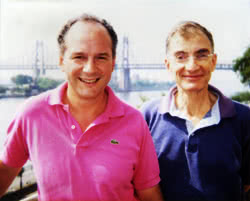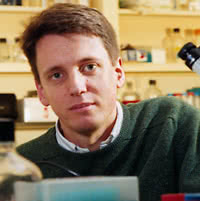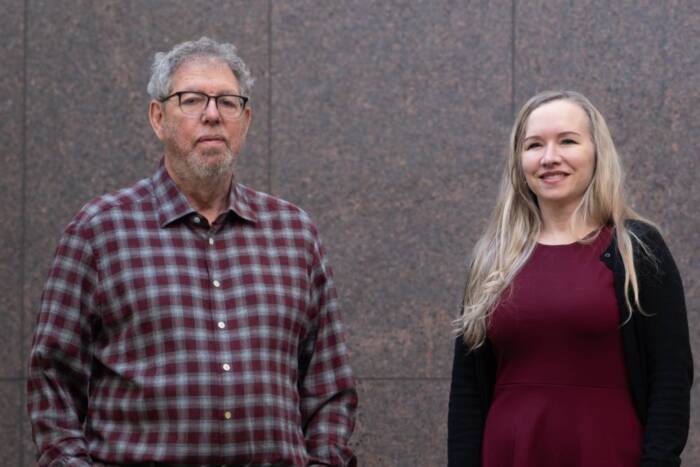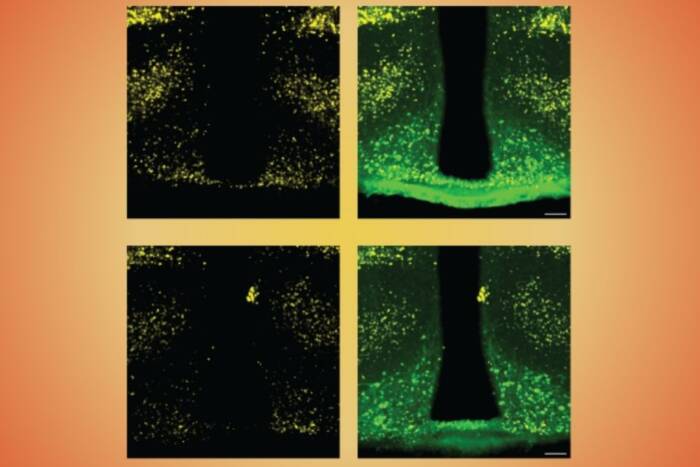Talking Science takes high school students on a journey through the history of drug development
by Wynne Parry, science writer
- Researchers Ricardo E. Gürtler (left) and Joel E. Cohen. Cohen heads the Laboratory of Populations at The Rockefeller University.
- Markus Stoffel
On a recent Saturday, about 350 students and 70 teachers from 50 New York City–regional schools took their seats in Caspary Auditorium for a whirlwind tour through the history of drug discovery. Their guide during the two-part lecture, which is part of the university’s annual Talking Science program, was Thomas P. Sakmar, Richard M. and Isabel P. Furlaud Professor and head of the Laboratory of Chemical Biology and Signal Transduction, whose own research aims to discover potential therapies. Dr. Sakmar is also a senior physician at The Rockefeller University Hospital.
His presentation surveyed 60,000 years, leading his audience up to the modern promise of precision medicine—and into an even more hopeful future.
Talking Science is a popular Rockefeller event dating back to 1959. Formerly known as the Holiday Lecture, and established by Alfred E. Mirsky, a biochemist and Rockefeller University librarian, it aims to engage high school students from across the city, following in the footsteps of chemist Michael Faraday’s holiday lectures to young audiences in London, in the early 1800s. The annual talk is accompanied by a lunchtime program with videos and science demonstrations, including one hosted by the Science Outreach Program.
Dr. Sakmar had both current and former students of his own in the audience, including physician-scientist Chris Min, who currently works at the pharmaceutical company Merck & Co., Inc. Together with Payal Sheth, also from Merck, Dr. Min participated in the lunchtime activities and spoke with high school students about their careers.
The day concluded with a special moment on stage when members of Dr. Sakmar’s laboratory took turns offering career advice to the budding scientists in the audience.
From herbs to small molecules to genomic-era drugs
During his presentation, Dr. Sakmar told stories of landmark drug development efforts, particularly those made by young people. He began with the first evidence for herbal medicines: a Neanderthal burial site containing medicinal plants and herbs. The first medicines were compounds from plants, and it wasn’t until the early 20th century that progress in chemistry made it possible to produce other types of drugs, including an early antibiotic, prontosil, developed from a dye.
Prontosil, it turned out, is metabolized into its active ingredient, sulfanilamide, which prevents bacteria from making folic acid. This discovery lead to the realization that specifically targeted small molecules can be used to fight off pathogens, said Dr. Sakmar.
The advent of molecular biology and DNA research in the mid-20th century once more increased options for drug development, Dr. Sakmar said, and the subsequent genomic era brought with it the prospect of precision medicine, in which treatments are tailored to individual patients based on the molecular characteristics of their ailment. The first such drug, ivacaftor, approved in 2012, treats cystic fibrosis caused by a mutation that occurs in about 4 percent of people with the disease.
“Why is the future bright? And, why will there be a place for you to discover a new drug, even though 45 new drugs have come out last year?” Dr. Sakmar asked his audience.
He then gave the numbers: Out of 21,000 known drug products, only 1,350 are unique chemical entities, and the rest are variations of other compounds. Only 324 receptors, most of them present on human cells, have been used as targets for drug therapy. And, of the 1,620 genetic diseases that can be inherited from parents to their children, only 105 have known responsible defects that can be targeted by drugs.
“This difference between 1,620 and 105—that is the future of precision medicine right there, and how you will contribute to targeting those genetic defects,” Dr. Sakmar said, noting the future of medicine also likely involves gene therapy, gene editing, cloning to replace defective cells, and stem cell research.
Merck was a generous corporate sponsor of this year’s Talking Science event, which also received support from Thomas H. Haines, a visiting professor in Dr. Sakmar’s lab.




